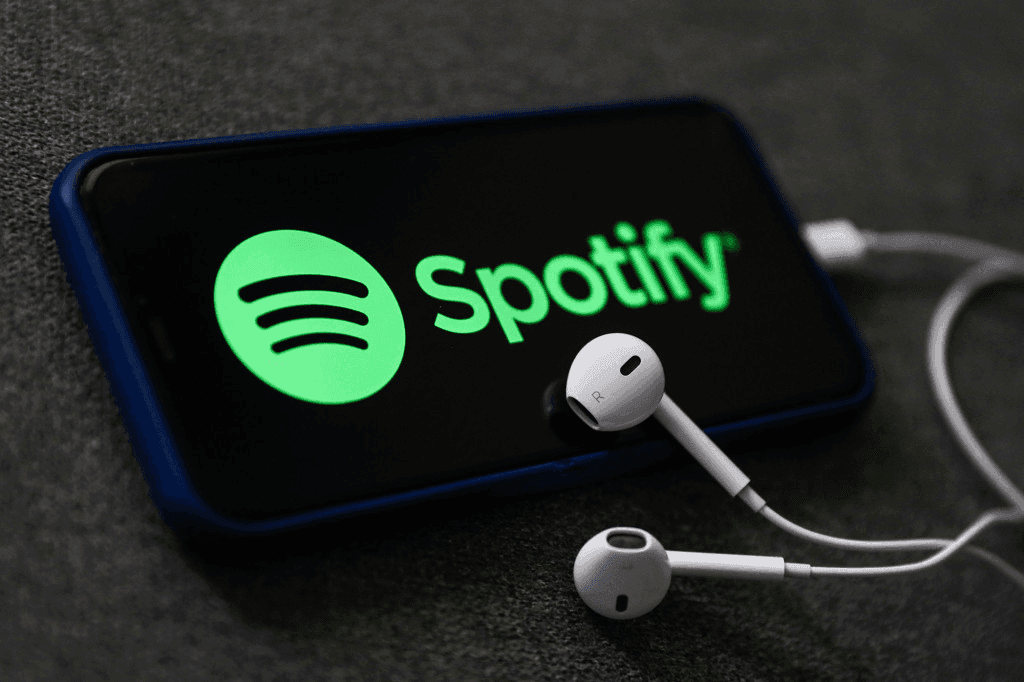Business Model of Spotify
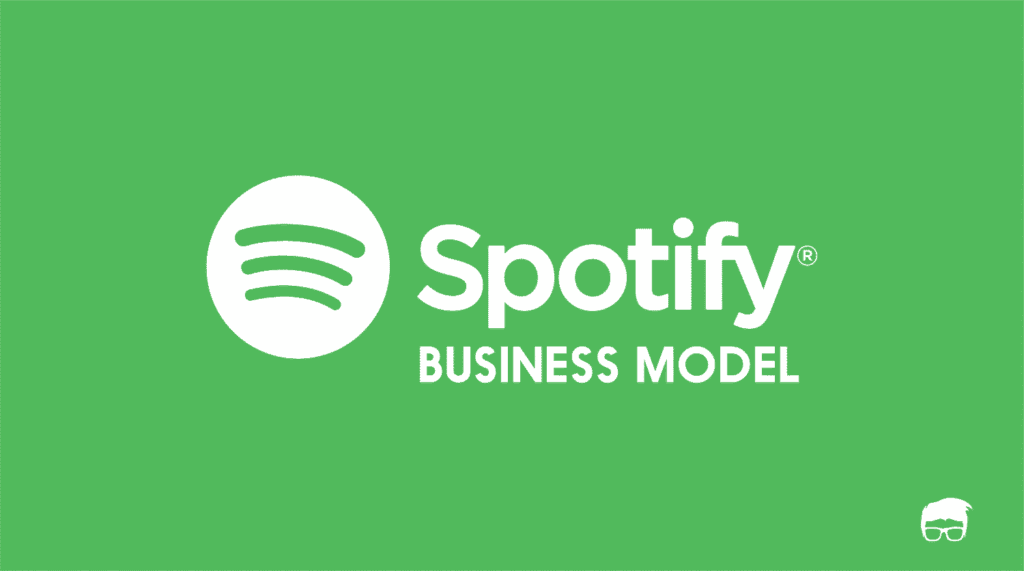
Source: Google
Spotify is a music streaming service that provides customers with access to a massive music library. It operates on a freemium revenue model, with a basic, ad-supported service available for free and an unlimited premium service available for a monthly charge. Spotify’s premium experience is largely dependent on its music algorithms and community of users and artists. Its premium membership base has increased from 10% of total users in 2011 to 46% in 2018. Spotify has always seen itself as a lawful alternative to pirated music and iTunes paid song purchases. Spotify pays royalties to music labels for a large chunk of its revenue.
Spotify Business Model: Market Share & Market Analysis
Spotify holds a dominant position in the music streaming market, capturing around 31% of the global market share as of 2023 (source: MIDiA Research). The business model of Spotify capitalises on the growing demand for on-demand music and personalised listening experiences. Spotify’s market analysis highlights the increasing consumption of digital music and the shift from ownership to access. The brand’s global reach and continuous innovation in user experience and content offerings keep it ahead of competitors.
Spotify Business Model: Product Offerings
Spotify’s product offerings include a vast music library, podcasts, and personalised playlists. The Spotify freemium model provides free ad-supported access and premium subscriptions that offer offline listening, an ad-free experience, and enhanced audio quality. Spotify for Artists and Spotify for Podcasters empower creators with tools for audience engagement and content monetisation. The introduction of Spotify HiFi and exclusive podcast content further diversifies its offerings and attracts different user segments.
Spotify Business Model: Target Audience
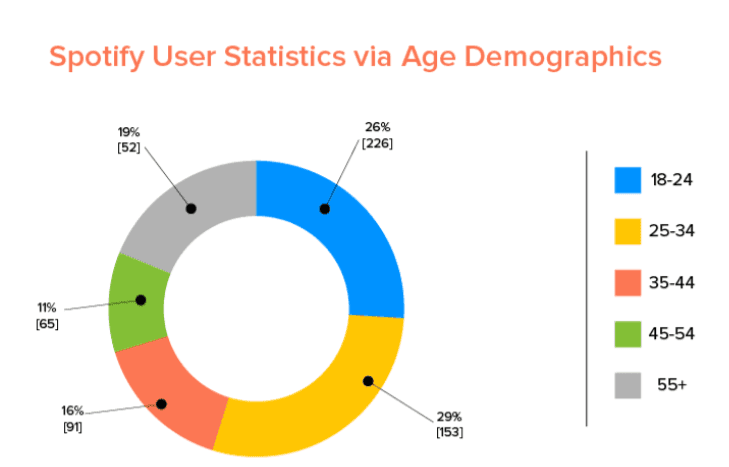
Source: Google
Spotify’s target audience encompasses a wide demographic, including music enthusiasts, podcast listeners, and creators. The platform appeals to various age groups, from teenagers to older adults, offering personalised content recommendations and diverse genres. Spotify for Business targets enterprises and commercial spaces, providing licensed music solutions. By catering to both consumers and creators, Spotify ensures broad market coverage and sustained user engagement.
Of course, this isn’t just the case with Spotify. Many other companies use strategies like these to promote their businesses and take them to the next level. Don’t believe us? Check out these digital marketing case studies and see for yourself.
Business Model Of Spotify: Funding & Investors
Spotify’s impressive growth can be attributed in part to its savvy financial strategy. The company has secured over $2 billion in funding from investors and a staggering $30 billion during its 2018 IPO. This continuous inflow of capital fuels strategic investments in content acquisition, cutting-edge technology, and global market expansion. These investments are key to maintaining Spotify’s innovation and leadership within the competitive music streaming industry.
So, if you are someone who is intrigued by the financial side of business, then know that the world of finance offers a multitude of exciting career paths. If you’re curious about exploring potential income opportunities, consider checking out a make-money-from-home free masterclass. This online workshop can introduce you to various remote work options, sparking your entrepreneurial spirit and equipping you with the skills to potentially build your own side hustle.
Business Model Of Spotify: Revenue Model
The Spotify revenue model is split into two sections:

Source: Google
Premium Services
Both paid and non-paying members have access to Spotify’s audio streaming service. However, paid subscribers, known as Premium Subscribers, can enjoy unlimited online and offline access to Spotify’s entire repertoire of music and podcasts without having to listen to advertisements. Subscription payments are how Spotify makes money from its Premium Service division.
In FY 2020, the division generated €7.1 billion in revenue, accounting for around 91% of total revenue. Spotify’s gross profit for the year was €2.0 billion, accounting for nearly all of the company’s profit. In comparison to FY 2019, the segment’s revenue increased by 17.2 per cent. In comparison to the previous year, gross profit increased by 22.3 per cent. The gross margin for the segment was 28%, up 1% from the prior year.
Ad-Supported Services
Spotify’s Ad-Supported Service is available to members who do not have a premium subscription. Users receive limited on-demand internet access to the company’s music library and unrestricted online access to its podcast library. Advertisements are placed throughout the user’s streaming experience.
The majority of Spotify’s Ad-Supported Service revenue comes from the selling of advertising across its music and podcast content. In FY 2020, the segment generated €745 million in revenue, accounting for nearly 9% of total revenue.
The segment’s gross profit was €6 million, accounting for a small portion of the company’s total gross profit. In comparison to FY 2019, the segment’s revenue increased by 9.9% but gross profit dropped 92.4 per cent.
Do you also find yourself fascinated by the stories behind such successful businesses? If so, then explore a collection of captivating case studies. Learn all about the business model of Netflix, the Business model of Zomato and the business model of McDonald’s. These in-depth analyses can provide valuable insights into the strategies and approaches that drive success.
Business Model Of Spotify: Marketing Strategy
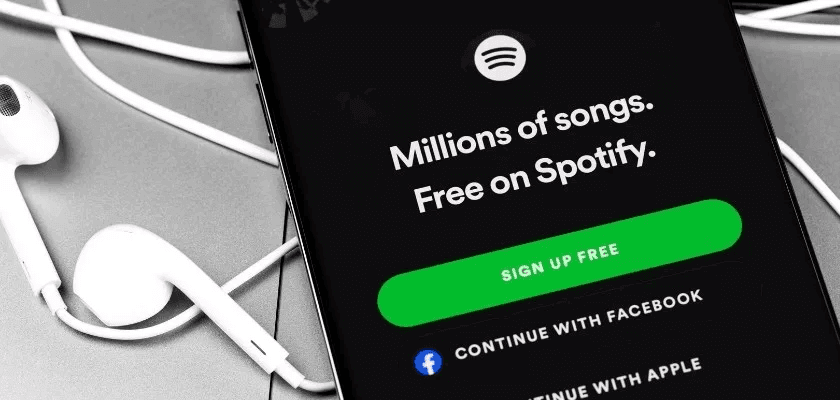
Source: Google
Spotify’s marketing strategy leverages data analytics, social media, and personalised recommendations. The company uses targeted advertising, influencer collaborations, and user-generated content to build brand awareness and loyalty.
Spotify Wrapped, which is an annual personalised summary of users’ listening habits, has become a viral marketing campaign, enhancing user engagement. The strategic use of playlists, podcasts, and exclusive content helps Spotify attract and retain a diverse user base.
Even a giant like Spotify recognises the power of digital marketing. They understand that online marketing is the future of business, and they’ve successfully leveraged it to reach a massive audience.
Thinking about following suit? If you believe digital marketing holds potential for your own business or career, there’s no better time to start learning. A digital marketing masters course can equip you with the skills and knowledge to develop effective online marketing strategies. This investment can propel you in the right direction and open doors to exciting new opportunities. But, if you are someone looking for a more flexible option then consider an advanced digital marketing course. This shorter programme can still provide valuable insights and practical skills without the same time commitment as a master’s degree.
Spotify Business Model: Value Proposition
The Spotify value proposition lies in offering a seamless, personalised, and diverse listening experience. The Spotify freemium model provides accessible music streaming for all, while premium subscriptions enhance the experience with added benefits. Spotify’s extensive library, algorithm-driven recommendations, and exclusive content ensure a unique user experience. The platform’s commitment to supporting artists and creators further strengthens its value proposition, fostering a vibrant and dynamic music ecosystem.
Spotify Business Model: Operational Model
Spotify’s operational model integrates advanced technology, data analytics, and strategic partnerships. The platform uses algorithms and AI to personalise recommendations and optimise content delivery. Spotify’s robust infrastructure supports seamless streaming and offline access, ensuring high user satisfaction. The company’s focus on continuous innovation and improvement in its operational processes drives efficiency and scalability, supporting its global expansion.
Spotify Business Model: Strategic Alliances & Partnerships

Source: Google
Spotify’s success isn’t solely based on its innovative platform. The company has cultivated a network of strong relationships through strategic alliances with various key partners. These partnerships play a crucial role in enhancing Spotify’s service offerings and propelling its growth. At the core of these alliances lie partnerships with Spotify key partners such as record labels, artists, and podcast creators.
This collaborative approach ensures a continuous stream of fresh and diverse content, keeping users engaged and satisfied. These partnerships not only enhance brand awareness for both Spotify and its collaborators but also foster deeper user engagement through unique experiences and content offerings.
Business Model Of Spotify: Technological Innovations
Spotify’s business model knows how to prioritise technology. AI and machine learning personalise recommendations and drive features like ‘Discover Weekly,’ keeping users engaged. Voice control and collaborative playlists further enhance the experience, solidifying Spotify’s place at the forefront of music streaming.
AI might be a game-changer, but it’s not the only player in the future of business. Digital marketing is another powerful force shaping how businesses connect with customers. If you’re interested in exploring the exciting world of digital marketing, there is a wealth of online digital marketing courses in India available. These courses can equip you with the skills and knowledge to navigate the ever-evolving digital landscape, potentially opening doors to new career opportunities. To help you decide if digital marketing is the right path for you, consider starting with a free digital marketing masterclass. This introductory session can provide valuable insights into the field and its potential.
Business Model Of Spotify: Corporate Social Responsibility (CSR)
Spotify’s CSR initiatives focus on sustainability, diversity, and community support. The company aims to minimise its environmental impact through initiatives like carbon offsetting and sustainable practices. Spotify’s commitment to diversity and inclusion is evident in its content curation and support for underrepresented creators. Community initiatives, such as music education programmes and support for local artists, highlight Spotify’s dedication to making a positive social impact.
Spotify Business: Top Competitors Analysis
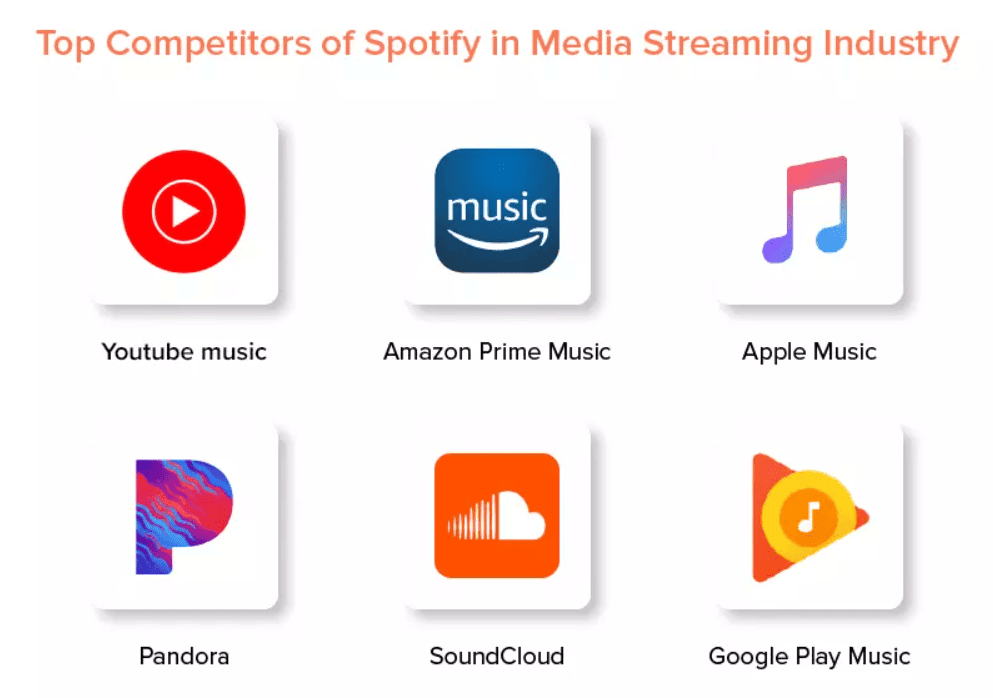
Source: Google
Apple Music: Boasting a massive library that rivals Spotify’s, Apple Music seamlessly integrates with Apple devices, creating a cohesive user experience within the Apple ecosystem. This tight integration, coupled with exclusive content deals and features like real-time lyrics, attracts a fiercely loyal user base of Apple device owners.
Amazon Music: Leveraging the power of the Amazon ecosystem, Amazon Music offers music streaming as both a standalone service and a perk bundled with Amazon Prime memberships. This bundled approach allows Amazon to capture a significant portion of the market already invested in its broader platform. Additionally, Amazon Music integrates with Alexa voice assistants, making it a convenient choice for hands-free music control within the home.
YouTube Music: This Google-owned platform combines music streaming with a vast collection of music videos, creating a unique offering that caters to a younger, more visually-oriented audience. YouTube Music leverages the existing popularity of YouTube for music discovery, allowing users to seamlessly transition from watching music videos to ad-free streaming.
Tidal: Standing out from the crowd, Tidal focuses on high-fidelity sound quality, offering lossless audio formats that appeal to audiophiles and music enthusiasts seeking a premium listening experience. Additionally, Tidal boasts exclusive content deals with artists, providing access to unique releases and concerts.
Deezer: Deezer offers a globally diverse music library with a strong presence in international markets. It boasts unique features like SongCatcher for music identification and Flow for personalised playlists, catering to a broad audience.
This competitive landscape pushes all music streaming services, including Spotify, to constantly innovate and improve their offerings.In a dynamic market like this, learning digital marketing is crucial to understanding user behavior, crafting effective marketing strategies, and staying ahead of the competition. By mastering digital marketing skills, Spotify can ensure its message resonates with the right audience, ultimately driving user acquisition and retention.
Learn From Asia’s #1
Digital Marketing Institute
AI-Based Curriculum
Dive in to the future with the latest AI tools
Placement at top brands and agencies








